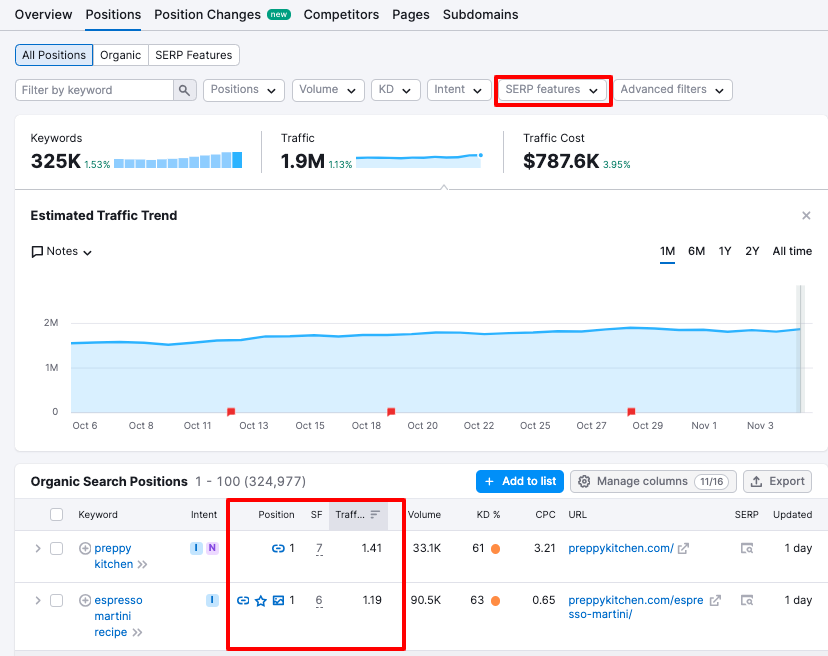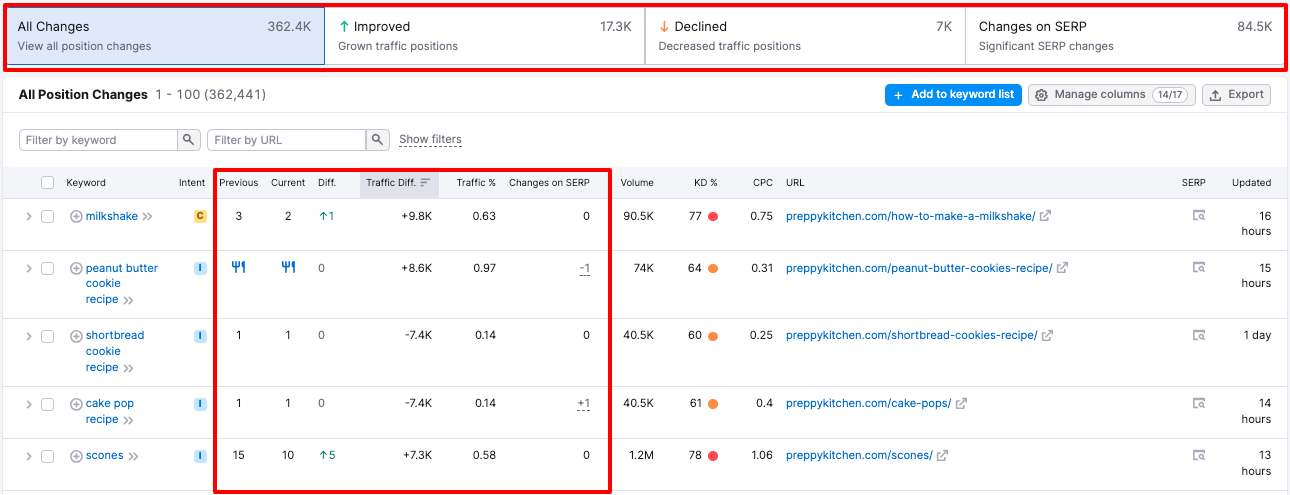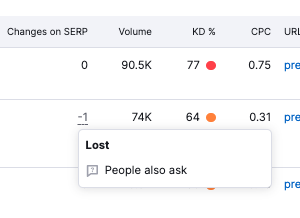Note: This article was originally published in April 2023. We’ve since updated it with information on more SERP features we’ve added to our toolkit in 2024.
You’re probably familiar with SERP features. We define them as any additional element on a search engine results page that adds something new to the typical format of a search result.
With these special results taking over Google, do you know how they’re helping or hindering your competitors?
We've just updated the data in Organic Research if you want access to that kind of data. Now, you can see if your competition is benefiting from the SERP features they rank for, and then use this data to find more opportunities for growth.
What’s New?
We’ve made a lot of changes to help your site grow. Previously, SERP feature rankings and organic positions were grouped together in one row. Now, you can evaluate a site's organic rankings and SF rankings separately.
You can now track:
- A total of 50 SERP features on Google's search engine results pages
- SERP feature positions and estimated traffic separate from traditional organic positions
- SERP feature trends over time on a daily basis
- Estimated traffic a domain gets from SERP features alone
Which SERP Features Do We Now Track?
We’ve increased the amount of SERP features you can track from 38 to 50. The recent additions in 2024 we’ve made include:
- Buying guides
- Things to know
- Discussions and forums
- Explore brands
- Questions and answers
- Datasets
- Organic carousel
- Popular stores
- People also search
- Refine
- Ads Middle
- AI Overviews
Here’s the full list:

You can see examples of all the SERP features we track on Semrush in our knowledge base. And you can see new SERP feature data in the following tools:
Why Is It Important to Track SERP Feature Data?
In the past, Google’s first page had 10 blue links and as an SEO, you’d find appropriate keywords to rank for that coveted first position.
But the SERP landscape has changed so much that it takes more than ranking for the first position to attract your target audience.
Kevin Indig sums up this trend pretty well:

Google’s showing more SERP features to help searchers. You should try to rank for all the SERP features your target keyword triggers, right?
Unfortunately, it’s not so simple.
Ranking for a SERP feature doesn’t mean you’ll get more traffic. Look at this featured snippet below, for example. No need to click through because the answer is right there.

The solution? Taking a holistic approach when you’re looking for new keyword ideas.
For instance, continue to choose keywords based on the right intent, difficulty, and search volume. But now you can also factor in SERP features triggered by these keywords and the data that comes with that to get the whole picture.
Without doing this, you could be targeting keywords that may seem like they’ll attract search traffic and they just won’t.
Ways to Use SERP Data in Your SEO Strategy
It’s easier to build a competitive SEO strategy when you know what brings the most traffic to your competitor.
Pretend you're a digital marketer and your client is a food blogger looking to get more web traffic. Let’s see how you could help your client by understanding their competitor’s SERP feature strategy.
Conducting Competitive Analysis
Go to Organic Research and type in the competitor’s domain.

After, navigate to the Positions report. Here you can either filter for certain SERP features at the top or look at the SF and Positions columns.

Then, you can see which SERP features are potentially driving the most traffic to their competitor by sorting by most to least traffic.
According to this table, the entered domain gets an estimated 90.5K monthly visits from organic search because of one recipe SERP feature that links to the website:

You could help your client create content around an original espresso martini recipe and then markup that page with recipe schema to improve the chances of getting a similar spot on the SERP.
Next, move to the Position Changes report.

This report shows you how a domain’s search position has changed for the keywords they rank for. You can analyze this month-over-month, day-to-day, or for any custom period. It also highlights which pages and keywords were most impacted by these changes.
First, use the Position Changes Trend widget to get a bird’s eye view of the site's overall trend in three areas: changes in traffic, number of improved keywords, and number of declined keywords. Then, use the Top Page Changes chart to the right to identify the site pages that had the largest traffic change in the previous month.

The All Position Changes chart explores this data in greater detail.

Here, you can compare a site’s position by keyword over time, including the amount of positions won or lost, and the change in traffic coming to the site from that keyword.
The “Changes on SERP” column shows you which changes on a SERP might have impacted your visibility on that page. For example, if your competitor lost a specific SERP feature, or if a new one appeared on the results page, you could find out by clicking on the figure in this column.

Use this report to identify keywords and SERP features your competitor has recently lost, which you can win.
Track SERP Feature Volatility in Sensor
Are you wondering how much movement there is among SERP features in your niche?
Semrush Sensor can show you. This tool has the ability to track volatility among 25 industries and 38 SERP features.

If there’s a lot of change among featured snippets, AI Overviews, people also ask boxes, or local packs, you can find out.
High volatility means it could be your time to shine… or, time to make sure you aren’t losing your spotlight!

How Do We Collect Data on SERP Features?
There are 3 types of SERP features that we track:
1) SERP features that enrich an organic position
Also known as “rich results,” these features add more information to an existing organic position. Examples include sitelinks, reviews, images, and videos.

In our toolkit, they’re represented by their unique SERP feature icon and position number.

2) SERP features that are independent of an organic position
The second group is SERP features that are detached from a standard organic ranking. Examples include knowledge panels, Twitter carousels, and recipe blocks.

They’re represented only with their unique SERP feature icon in the Positions column. There is no specific position we can attach to these because they are not directly tied to a “traditional” organic listing, like sitelinks or review stars.

3) SERP features that don’t link to a domain
The last group of SERP features we can analyze either don’t link to a domain at all, or we can’t gather that data at this time. Examples in this category include instant answers, featured images, and flights.

When you’re in Organic Research, you’ll be able to know when one of these features is on a keyword’s SERP because it will be listed in the “SF" column.

You can sort that information using the new filter in Organic Research.
See Which SERP Features Are Helping Your Competitors
When you have data to help you make decisions, you make better decisions. We think this update will allow you to:
- Conduct better competitive analyses
- Analyze SERPs faster
- Find hidden SEO insights
- Find more opportunities for search traffic
- Report growth on a granular level
So, start analyzing your competitor's SERP features before they analyze yours. Then, come up with a plan that will get your brand all over the SERPs—and watch your traffic roll in.
Read more about the new SERP features you can now track with the links below.
- AI Overviews
- Short Videos
- Web Stories
- Application
- Application List
- Recipes
- Twitter Carousel
- Find Results On
- Indented
- News
- Events
- Address Pack
- See Results About
- Related Products
- Popular Products
- Buying Guide
- Organic Carousel
- Things to Know
- Datasets
- Discussions and Forums
- Explore Brands
- Questions and Answers
- Popular Stores
- Refine
- People Also Search
- Ads (Middle)